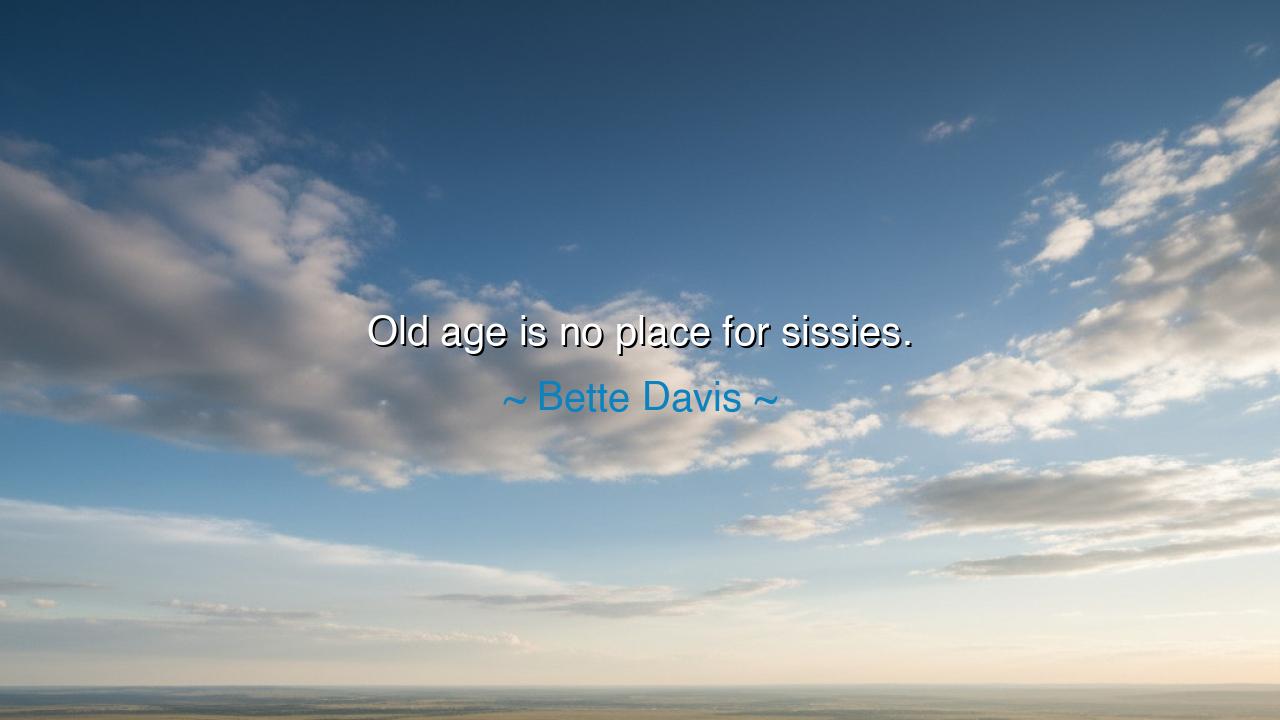
Old age is no place for sissies.






"Old age is no place for sissies." These bold words from the legendary Bette Davis pierce the veil of romanticized notions about aging, casting light on the harsh truth that the later years of life demand strength, resilience, and a kind of courage that cannot be taken lightly. Davis, a woman whose career spanned decades, recognized that the challenges of old age are not for the faint of heart. In her own life, she faced the relentless passage of time, and with it, the inevitable decline of the body and the challenges of living in a world that often devalues the elderly. Through her words, she calls us to acknowledge that old age is not a time for weakness, but a period that requires fortitude, resolve, and an inner strength that can only come from a life fully lived.
In our youth, we are carefree, full of ambition, driven by the vigor of our bodies and the hope of boundless possibilities. We imagine that with age comes the reward of peace, the relief of having earned the right to rest. But this ideal—this vision of a peaceful old age—is often a delusion. Old age, as Davis so bluntly points out, is not for the soft-hearted. It is a time when the body grows frail, when the spirit is tested by the slow erosion of physical strength, and when the challenges of living become more difficult. There is no escape from the reality of age; it is not a time to shy away from difficulties, but a time to confront them with grit and determination.
Consider the story of Queen Elizabeth I, who ruled England with unparalleled strength and grace well into her later years. Despite the challenges of age, with her health failing and her energy waning, she remained at the helm of her kingdom, displaying a unyielding courage in the face of adversity. Elizabeth’s reign was a testament to the resolve of an aging woman who refused to relinquish power or allow her physical decline to overshadow her duty to her people. Her strength in those later years was not born of physical prowess but of an indomitable spirit, a will that could not be broken. She lived in an era that saw the old as weak, yet she proved that old age requires strength, not surrender.
Similarly, Leonardo da Vinci, though known for his brilliance in his youth, demonstrated the perseverance of old age as he worked well into his later years. His body became frail, and his once steady hand trembled, yet his mind never ceased to imagine, to invent, and to create. His spirit, the core of his being, was undeterred by his body’s decay. His final works, filled with deep understanding and creative genius, proved that old age is not for the timid. It is for those who possess the will to continue despite the limitations of the body. Da Vinci’s legacy reminds us that it is not our physical condition that determines our worth, but our unwavering commitment to continue living a purposeful life.
Davis’ words urge us to face the reality of aging. To grow old is not a time to be fragile or afraid; it is a time to be strong in our acceptance of the changes that come with time. The weakness that many associate with aging is not inherent in the process itself, but rather in the mindset that accompanies it. The elderly who flourish are those who embrace their age with strength and a will to continue to contribute, to learn, and to live, regardless of the physical changes they endure. It is a battle, yes, but one that is fought with the weaponry of experience, wisdom, and courage.
The lesson Davis imparts is simple: old age demands of us fortitude, the same fortitude that has carried us through the trials of youth and middle age. It is not a time for surrender, but a time for acceptance and strength in the face of inevitable change. In our own lives, we must begin now to prepare for the challenges that old age brings—not just by taking care of our bodies but by nurturing our spirits, by building resilience, and by maintaining a purpose that will carry us through. Aging is not something that can be avoided, but it is something that can be faced with the same courage that we summon in the face of any challenge.
So, let us live today in such a way that when the years begin to weigh upon us, we are ready. Let us strengthen our hearts, our minds, and our bodies with the same determination we have in youth. Let us embrace old age not as a time of retreat, but as a new chapter of our lives—one that will demand of us the bravery to live fully, despite the limitations that time may impose. And let us remember that old age, when met with strength and grace, can be as beautiful and rewarding as any other stage in life. It is a work of art, one that is crafted with every year we live.






AAdministratorAdministrator
Welcome, honored guests. Please leave a comment, we will respond soon